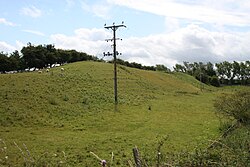Northallerton Castle
| Northallerton Castle | |
|---|---|
| Northallerton, North Yorkshire in England | |
 Mound at Castle Hills in Northallerton | |
| Coordinates | 54°20′28″N 1°26′46″W / 54.341°N 1.446°W |
| Grid reference | SE365940 |
| Type | Motte and Bailey castle |
| Site history | |
| Built | c. 1068 |
| Materials | Timber |
| Fate | Demolished c. 1178 |
Northallerton Castle was a defensive structure in Northallerton in North Yorkshire, England. The structure is thought to have been constructed c. 1068 and was largely made out of timber with a palisade wall. It was destroyed by order of King Henry in 1178. The ground outlines of the site were removed by railway building in the first half of the 19th century.
History
[edit]Northallerton Castle, located at what would become known as Castle Hills in the town, was also the site of a possible Roman camp. It was the first of two castles built in Northallerton, though the Bishop's Palace site, the later castle, was more of a fortified manor house.[1] A motte and bailey south-west of the church is recorded as far back as 1068, and a castle was also recorded in the 1140s,[2][note 1] as a property of the Bishop of Durham, being seized by William Cumin as a way of extending the Scottish border southwards.[4] Edwards and I'Anson state that the castle was built by King William in 1068, who was known to have encamped at Northallerton whilst conducting the Harrying of the North.[5][6]
In 1143, Cumin surrendered the castle to his nephew, Richard Comyn.[7] However, a castle is thought to have been built by Bishop Hugh Pudsey in 1174, who took part in a rebellion against Henry II, leaving the castle in the safe keeping of his nephew, Hugh Count of Bar.[8][9] Pudsey is also referred to as having "greatly enlarged" the castle at Northallerton around 1174 (the time mentioned above when he was also attributed with its initial building) as a way of providing security for his estates in Allertonshire.[10][11]
It is known that the location of Castle Hills (SE365940) was the site of some defensive structure made from timber. The great tower and a palisade wall are thought to have been made from wood, but the rest of the castle is undetermined in its structure.[12]

A castle was mentioned near to Northallerton during the Battle of the Standard (1138) and since neither of the subsequent castles in Northallerton were in use at that time, it is thought to be the Norman motte at Yafforth, the mound of which is still obvious in modern times.[13] In 1177, Bishop Hugh Pudsey was required to appear before Henry II and account for his actions, having been suspected of allowing Scottish troops free access across his lands in years previous. Pudsey paid a retainer into the royal coffers and surrendered all his castles, however, some reports state that the castle at Northallerton (castellum novum de alverton) was spared, but later destroyed on the wish of the king.[14][15]
Only the north-eastern arc of the castle edge remains - the rest of the site was destroyed when the railway was built through the location in 1838.[16] Whilst it was being dug out for the tracks, a selection of stones were found, one bearing the inscription INSTANE FLA. HYRO LEG. VI V. However, the stone was lost in 1877.[17]
Notes
[edit]References
[edit]- ^ I'Anson 1913, p. 368.
- ^ Turner 2004, p. 244.
- ^ Ingledew 1858, p. 110.
- ^ Illingworth, John Lawson (1970). Yorkshire's ruined castles: an account of their history, associations and architecture with a chapter on the fortified houses of the county with plans of the castles, glossary of medieval military architecture, arms and armour. Wakefield: S. R. Publishers. p. 129. ISBN 0-85409-602-7.
- ^ Edwards, William (1924). The early history of the North Riding. London: A. Brown and Sons. p. 70. OCLC 4877773.
- ^ Page, William, ed. (1968). The Victoria History of the Counties of Britain, Yorkshire, the North Riding Volume One. London: Dawsons. p. 35. OCLC 878120.
- ^ Saywell 1885, p. 19.
- ^ Saywell 1885, p. 17.
- ^ Whitworth, Alan (2004). Northern strongholds / volume 1 North Yorkshire. Whitby: Culva House. p. 53. ISBN 1-871150-32-9.
- ^ Ingledew 1858, p. 114.
- ^ Saywell 1885, p. 20.
- ^ Fry, Plantagenet Somerset (1996). Castles of Britain and Ireland: the ultimate reference book with over 1,350 gazetteer entries. Newton Abbot: David & Charles. p. 165. ISBN 9780715302422.
- ^ Turner 2004, p. 69.
- ^ Ingledew 1858, p. 116.
- ^ Riordan, Michael (2002). The history of Northallerton : from the earliest times to the year 2000. Pickering: Blackthorn Press. p. 24. ISBN 0-9540535-0-8.
- ^ "Castle Hills". heritagegateway.org.uk. Retrieved 5 August 2022.
- ^ "North Yorkshire HER". heritagegateway.org.uk. Retrieved 4 July 2023.
Sources
[edit]- I'Anson, William (1913). "The Castles of the North Riding". Yorkshire Archaeological Journal. 22. Leeds: Yorkshire Archaeological Society. ISSN 0084-4276.
- Ingledew, C. J. Davison (1858). The history and antiquities of North Allerton [sic], in the County of York. London: Bell & Daldy. OCLC 561728609.
- Saywell, Joseph Lemuel (1885). The history and annals of Northallerton, Yorkshire. London: Simpkin Marshall. OCLC 5739521.
- Turner, Maurice (2004). Yorkshire Castles. Otley: Westbury Publishing. ISBN 1-84103-026-0.

